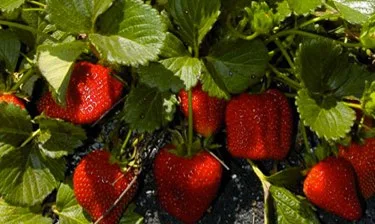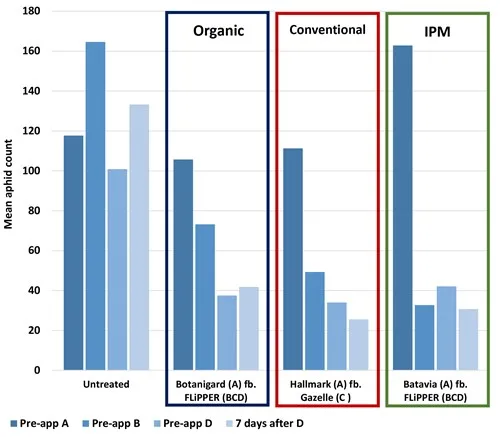
Integrating biological insecticides into a pest management programme for strawberries and other soft fruit
Author
| 12th April 2022Tags
Strawberry IPM trial reveals simple step to better aphid control
Integrating biological insecticides into a pest management programme for strawberries and other soft fruit is not without its considerations. New findings from trials performed by crop advisers and research specialists Agrii, suggests that where IPM policies are implemented successfully, the protection achieved can be consistent with that seen when following a programme based on conventional products alone.
The trial, performed at the Agrii trials iFarm at East Malling, investigated how the control of an IPM programme compared with that achieved by a conventional regime and that required for organic certification.
The findings, says Richard Killian, technical manager and Agrii fruit agronomist, should give soft fruit growers the confidence to incorporate more biological insecticides into programmes without fear of compromising protection.
“Effective use of biologicals is largely about achieving the right balance with other forms of intervention. We have known for a long time that biologicals work best in the shadow of conventional products. This trial sought to develop our understanding of when and how to bring the two forms of protection together for best results,” Mr Killian says.
Specifically, the trial considered how to order products in a programme for effective control with the minimal number of conventional applications and, importantly, if conditions at the time of treatment were significant to performance.
1. Apply when dew on the plant
With the bio-insecticide Flipper (fatty acids C7-C20), previous work has suggested that there was a benefit to applying ‘on the dew line’: when water droplets form on the leaf surface through condensation, providing a longer drying time for the product on the leaf.
“Earlier work found that where Flipper was applied on the dew, it consistently led to lower aphid numbers. We needed to understand what this meant to performance across the programme. It was significant. At seven days after the final application, the aphid population was 44% lower where Flipper had been applied on the dew than in the programme where it was applied to a dry leaf,” Mr Killian says.

FLiPPER applied on the dew delivered improved protection
| | Timing | |
| --------- | ------------------------ |
| A | 14-days before flowering |
| B | Beginning of flowering |
| C | Full flowering |
| D | End of flowering |
Source: Agrii, Kent, 2021 Cv. Malling Champion; water rate: 500 litres/ha
2. First spray timing crucial to IPM success
The need to investigate such nuances in the application of biological products is necessary to optimise their use in an IPM programme. Due to the loss of previously relied on conventional products there is a need to maximise the performance of biological products while protecting the beneficials.
“The success of any IPM approach is to time the first spray when it will be most worthwhile. We found that where Batavia (spirotetramat) is well-timed, subsequent applications of Flipper on the dew, can be effective at keeping aphid populations in check. At seven days after the final spray, numbers in the IPM programme were close to that seen in the conventional programme based on Hallmark with Zeon Technology (lambda-cyhalothrin) followed by Gazelle (acetamiprid) even though the initial aphid count in the IPM plots was higher,” Mr Killian says.

FLiPPER applied on the dew led to protection in line with that achieved under a conventional approach
| | Timing | |
| --------- | ------------------------ |
| A | 14-days before flowering |
| B | Beginning of flowering |
| C | Full flowering |
| D | End of flowering |
Across the trial there was a mix of aphid species with the potato aphid (Macrosiphum euphorbiae), the melon-cotton aphid (Aphis gossypii) and the black bean aphid (Aphis fabae) all easily detected.
Bayer will continue to support further trials investigating how the contribution biological crop protection agents of all forms can be successfully incorporated in to crop protection strategies. Developing a greater understanding of how the many forms of biological products work in practice is essential to harnessing their potential and reducing reliance on synthetic forms of protection.